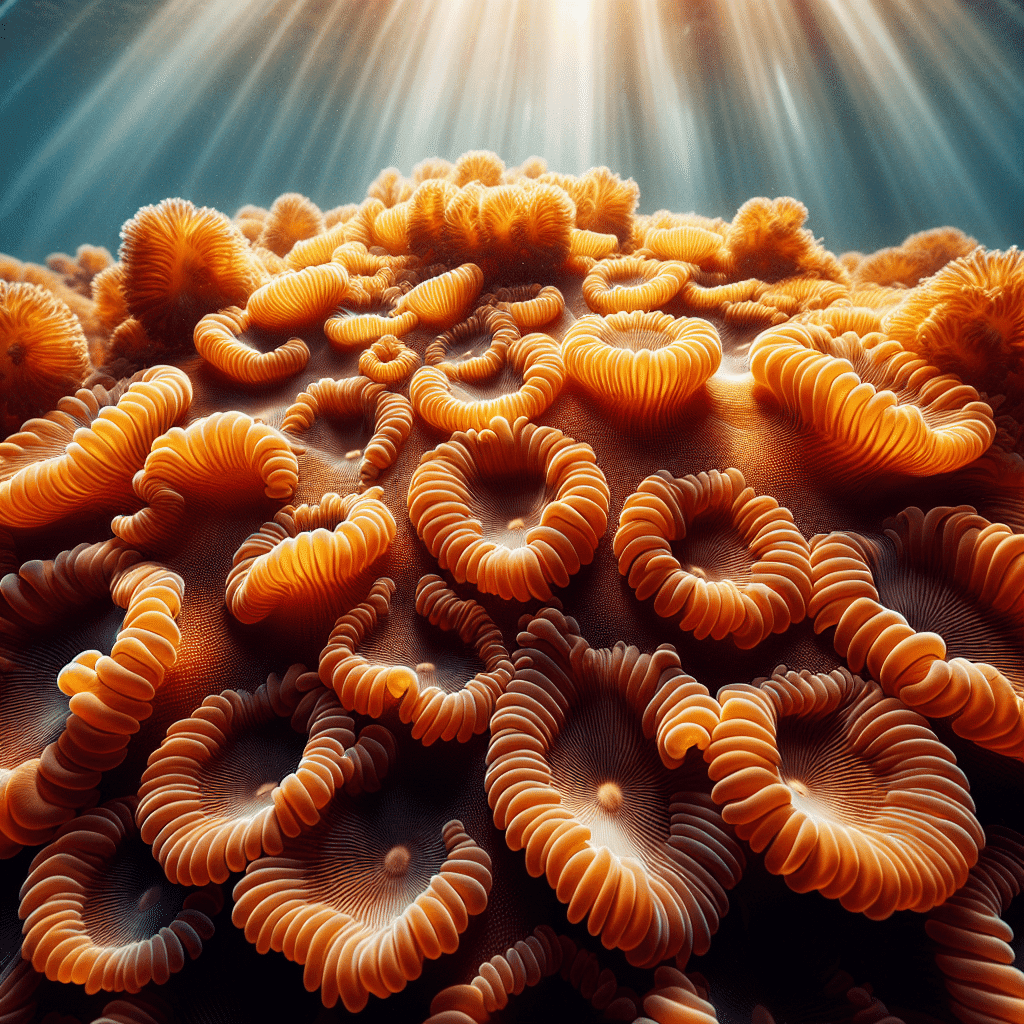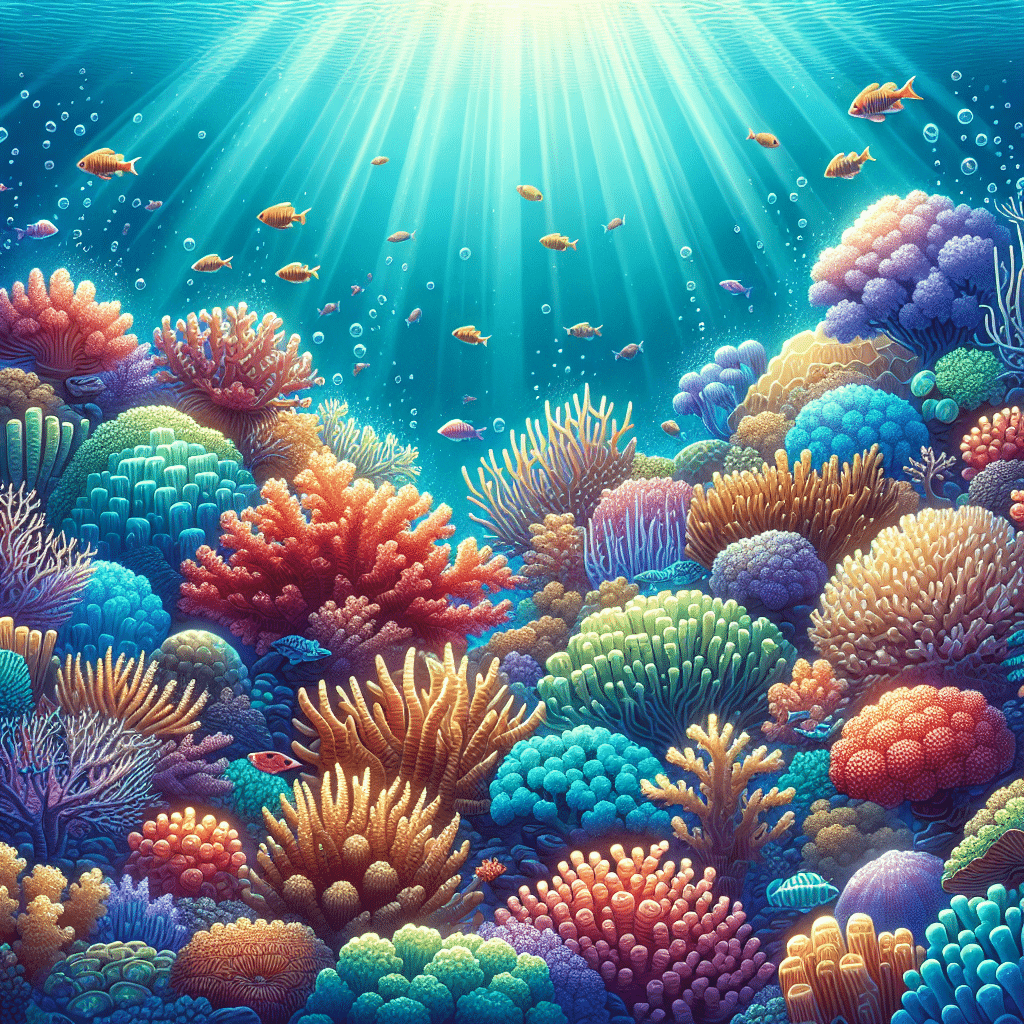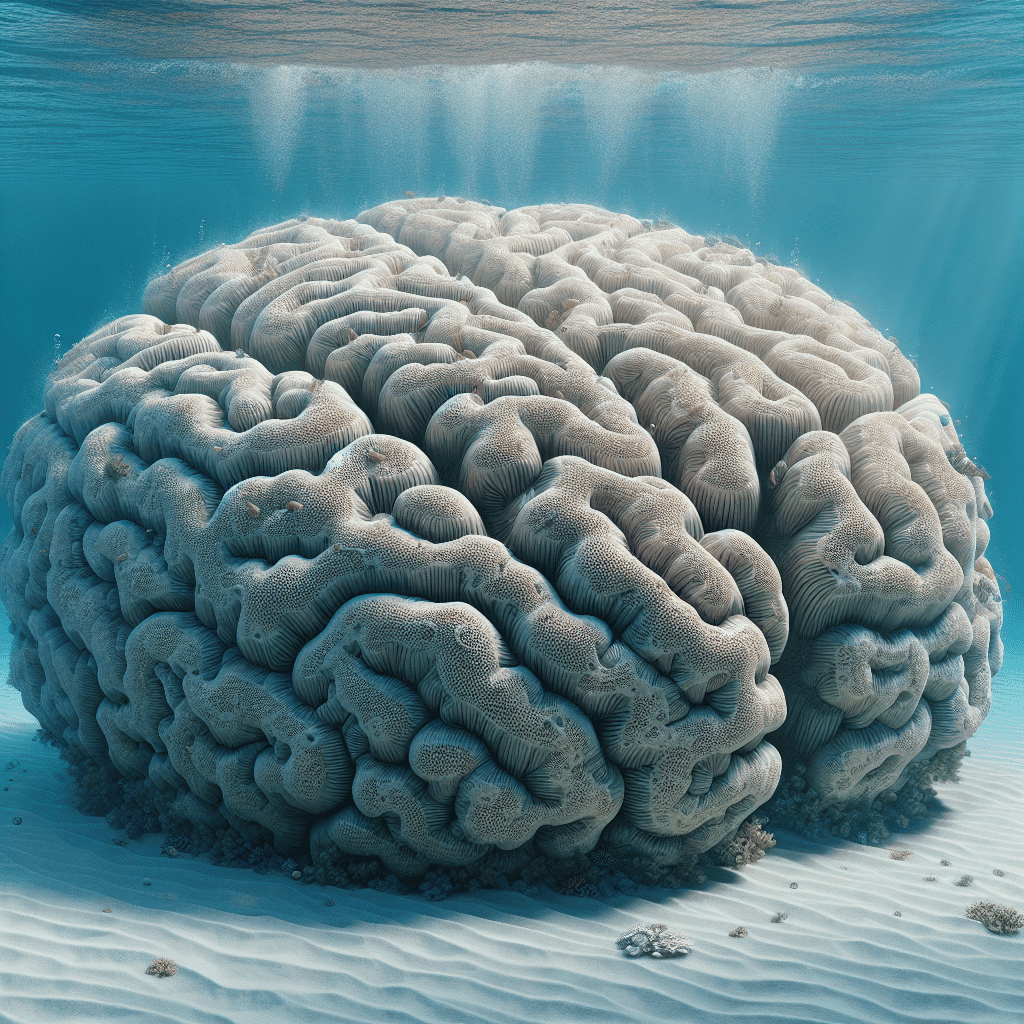Understanding Sun Corals
Habitat and Distribution
Sun corals, belonging to the genus Tubastraea, thrive in shallow tropical and subtropical waters, typically found between 35°N and 35°S latitude. They are commonly located in the Pacific, especially around the Indo-Pacific islands, such as Fiji, Tonga, the Solomon Islands, and the Great Barrier Reef. These corals prefer warm waters with temperatures ranging from 23° to 29°C (73.4° to 84.2°F), but they can tolerate temperatures as high as 40°C (104°F) for short periods.
| Temperature Range | Optimal | Tolerable |
|---|---|---|
| 23° – 29° C | Yes | 40° C (short-term) |
Unique Characteristics
One of the most fascinating aspects of sun corals is their non-photosynthetic nature. Unlike many other coral species, they do not rely on sunlight or the symbiotic algae, zooxanthellae, to derive energy. Instead, they are known for their striking bright yellow and orange colors, which make them popular among hobbyists (Tidal Gardens, Aquarium of the Pacific).
Sun corals are also aggressive feeders, catching food using their long, tentacle-like arms. They extend these tentacles at night to feed on zooplankton, requiring a significant amount of food to thrive. This feeding behavior is critical to their survival, and many hobbyists underestimate their nutritional needs, which can lead to starvation and death (Tidal Gardens).
In summary, the combination of their unique feeding habits and vibrant colors make sun corals a captivating addition to any reef tank. For more information on other types of corals, check out our sections on brain coral and mushroom coral.
Care and Maintenance
Taking care of sun corals can be a rewarding experience. Here’s what I’ve learned about their requirements regarding water temperature, lighting, feeding, and reproduction.
Water Temperature and Lighting
Sun corals thrive in warm water, ideally between 23° and 29° C (73.4° and 84.2° F). They can tolerate higher temperatures, up to 40° C (104° F), for short periods, but it’s best to keep them within their preferred range for optimal health (NOAA).
Interestingly, sun corals do not contain the symbiotic algae zooxanthellae, which means they can live without direct sunlight. However, they typically inhabit shallow tropical and subtropical waters, so providing a well-lit environment can help mimic their natural habitat.
| Temperature Range | Ideal | Tolerable |
|---|---|---|
| Celsius | 23° – 29° | Up to 40° for short periods |
| Fahrenheit | 73.4° – 84.2° | Up to 104° for short periods |
Feeding Requirements
Feeding sun corals can be quite fun, as they are active hunters. They primarily feed at night, using their long tentacles to catch zooplankton. In an aquarium, they will accept a variety of foods, including mysid shrimp, brine shrimp, and bits of fish or clam.
It’s essential to feed them multiple times a day while being cautious not to overfeed, as this can lead to high phosphate and nitrate levels in the water, which could harm the tank environment. I usually try to establish a feeding schedule to make them comfortable, and I’ve found that with consistent feeding at specific times, they can even be trained to open up during the day.
| Food Types | Examples |
|---|---|
| Zooplankton | Natural diet |
| Marine Proteins | Mysid shrimp, brine shrimp, fish, clam |
Reproduction Methods
Sun corals reach reproductive age at around 1.5 years and can reproduce in several ways. They can reproduce sexually, asexually, and through runners that grow away from the colony (Aquarium of the Pacific). This adaptability is one of the reasons they thrive in various environments.
Understanding these aspects of care and maintenance can make a significant difference in keeping sun corals healthy and vibrant in your tank. For more information on other types of corals, check out articles on brain coral, torch coral, and mushroom coral.
Challenges Faced by Sun Corals
Sun corals, while beautiful and fascinating, face several challenges that can impact their health and survival. It’s important for hobbyists like me to understand these issues to help maintain the well-being of these corals in our tanks.
Algae Growth and Damage
One major threat to sun corals is the growth of algae. These corals are very susceptible to damage caused by algae. If algae begins to grow on the coral, it can slowly lead to its decline. Fortunately, sun corals tend to thrive in darker areas, which helps them avoid direct competition with algae and other encroaching corals.
To prevent algae growth in my reef tank, I focus on maintaining good water quality and keeping nutrient levels low. This often involves regular water changes and monitoring levels of phosphates and nitrates. In addition, I make sure to incorporate adequate filtration and flow to help keep the water clean.
Invasive Species Concerns
Another challenge that I have to be aware of is the invasive nature of sun corals, particularly Tubastraea coccinea. This species can attach itself to artificial surfaces, such as oil rigs and boats, allowing it to spread widely. While it’s great that sun corals can thrive in various environments, their ability to become invasive can threaten native coral populations and ecosystems.
Being aware of the origins of any sun corals I introduce to my tank is essential. I make it a point to source them from reputable vendors who practice responsible harvesting methods. This way, I can help minimize the risk of inadvertently contributing to the spread of invasive species.
Overall, it’s crucial for me and other hobbyists to stay informed about the challenges sun corals face. By being proactive in addressing these issues, we can help ensure a healthier environment for our corals and promote the overall health of our reef tanks.
Importance of Sun Corals
Sun corals play a significant role in marine ecosystems, contributing to the health of coral reefs and supporting various marine life. Their unique characteristics and behaviors make them essential, not only for their immediate environment but also for broader ecological stability.
Ecosystem Contributions
Sun corals provide a habitat for numerous marine species. They create complex structures that offer shelter and breeding grounds for fish and invertebrates. This biodiversity is crucial for maintaining a balanced ecosystem. Additionally, sun corals contribute to nutrient cycling within the reef system, which is vital for the overall health of coral reefs.
The presence of sun corals can enhance the beauty and complexity of reef habitats, attracting divers and snorkelers, which can promote local ecotourism. This demonstrates how sun corals not only support marine life but also have economic significance for coastal communities.
Conservation Efforts
Conservation efforts aimed at protecting sun corals are vital due to various threats they face. Human activities such as coastal development, pollution, and climate change have detrimental effects on coral health. Efforts to preserve coral reefs include reducing land-based pollution, implementing sustainable fishing practices, and preserving marine protected areas.
Organizations and researchers work tirelessly to raise awareness about the importance of corals, including sun corals, in maintaining healthy ocean ecosystems. By promoting responsible tourism and educating the public, they aim to foster a culture of conservation.
At home, as a hobbyist, I can contribute by ensuring my aquarium setup mimics natural conditions, providing proper care, and avoiding harmful practices. Learning about different coral species, such as brain coral and torch coral, helps me understand the diversity and importance of these marine organisms.
By recognizing the importance of sun corals and participating in conservation efforts, I can help ensure these beautiful creatures continue to thrive in our oceans.
Impact of Human Activities
Coral Reef Preservation
I’ve learned that preserving coral reefs is crucial for maintaining the health of our oceans. Coral reefs provide essential habitats for many marine species and contribute significantly to biodiversity. However, human activities often threaten these ecosystems. The health of coral reefs can be impacted by activities that occur on land, even those far from the coast, not just those directly on the water (EPA).
Efforts to preserve coral reefs include:
| Preservation Efforts | Description |
|---|---|
| Marine Protected Areas | Designated zones where human activities are restricted to protect marine life. |
| Sustainable Fishing Practices | Methods that minimize damage to coral habitats while allowing for fish harvesting. |
| Pollution Control | Reducing runoff from lawns, sewage, and farms to prevent nutrient overload in oceans. |
| Public Awareness Campaigns | Educating the public about the importance of coral reefs and ways to protect them. |
Threats to Coral Health
Unfortunately, coral health is under constant threat from various human activities. Development often causes ocean water quality to suffer, impacting corals. Runoff from cities and farms can feed algae that overwhelm reefs, while toxins, excessive nutrients, pathogens, and trash can also interfere with coral health (Smithsonian Ocean).
Some of the significant threats to coral health include:
| Threat | Description |
|---|---|
| Physical Damage | Accidental ship groundings, dropping heavy anchors, and dredging can physically harm coral structures. |
| Microplastics | Research indicates that corals ingest microplastics, mistaking them for food particles, which can harm coral health. |
| Harmful Chemicals | Sunscreen chemicals can transform into potent toxins, causing corals to bleach. |
Understanding these impacts can help me and other reef tank hobbyists make informed choices that benefit not only our aquariums but also the natural ecosystems that support sun coral and other coral species.
Sun Corals in Aquariums
Setting up and caring for sun corals in an aquarium can be a rewarding experience. These unique corals are not only beautiful but also fascinating in their feeding habits and reproduction methods. Here’s how I manage my sun corals in a reef tank.
Aquarium Set-Up
When I set up my aquarium for sun corals, I focus on mimicking their natural environment. Sun corals thrive in environments that are low in light since they do not contain the symbiotic algae zooxanthellae. Here are some key points for setting up:
| Feature | Recommendation |
|---|---|
| Lighting | Use daylight-colored lighting; avoid intense lighting to prevent burning. |
| Water Flow | Moderate to low water flow is ideal to allow for tentacle extension without stress. |
| Temperature | Maintain water temperature between 72°F and 78°F (22°C – 26°C). |
| Water Quality | Regularly check and maintain low phosphate and nitrate levels to avoid tank crashes. |
Sun corals can be quite aggressive feeders, so giving them plenty of space is also essential to prevent them from crowding out other corals in the tank.
Feeding in Captivity
Feeding sun corals is one of the most important aspects of their care. In the wild, they feed on zooplankton, but in my aquarium, I provide a variety of foods, including mysid shrimp, brine shrimp, and bits of fish or clam. Here’s my feeding routine:
- Frequency: I feed my sun corals multiple times a day. Consistency is key, as they can be trained to open during the day if fed at regular intervals (Tidal Gardens).
- Amount: I ensure not to overfeed, as this can lead to high levels of phosphates and nitrates, which could eventually crash the tank.
- Technique: I usually use a feeding syringe to target the food directly into the coral’s tentacles, ensuring they get enough nutrition without excess food polluting the water.
Reproduction in Controlled Environments
Sun corals can reproduce in several ways, including sexually and asexually. They reach reproductive age at about 1.5 years, which is when I start observing their reproductive behaviors. Here are some insights on their reproduction:
- Sexual Reproduction: In a healthy tank, sun corals can spawn, releasing eggs and sperm into the water column. This usually occurs at night.
- Asexual Reproduction: They can also reproduce asexually by developing runners that grow away from the main colony. This method allows them to expand their territory in the aquarium.
- Care Considerations: Maintaining optimal water quality and ensuring they have enough food are crucial for successful reproduction.
In summary, keeping sun corals in an aquarium requires attention to their specific needs regarding environment, feeding, and reproduction. This attention not only keeps them healthy but also fosters a thriving coral community in my reef tank. For more information on other types of corals, feel free to explore articles on brain coral, mushroom coral, and torch coral.



